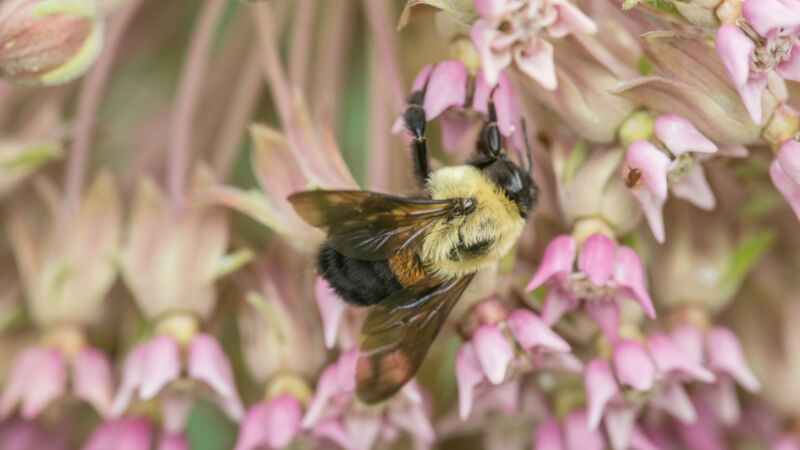
Why Monarchs? While monarchs are intrinsically important, conserving monarchs matters for more than just their own protection. We’re exploring the ways that monarch habitat and conservation help people, other wildlife, and the environment in this ‘More than Monarchs’ series! Join us to learn more.
The insect most commonly associated with milkweed is the monarch butterfly, but many other insects contribute to the well-being of milkweed populations. Some of these are bumble bees. The U.S. boasts over 45 native bumble bee species1, and these fuzzy insects pollinate hundreds of plant species, from wild prairie flowers to crops and garden vegetables.
Across all of North America, bumble bees are known to pollinate different species of milkweed in a wide variety of habitats, such as prairielands, marshes and woodlands. Milkweed flowers are not easy for insects to access. Their petals have hood-like shapes that conceal bundles of “pollinia”—clusters of packed-together pollen rather than loose pollen grains. However, bumble bees are robust and adaptable pollinators who can overcome the difficulties of many shapes of flowers. These bees have been observed sticking their legs far into the hooded milkweed flowers, allowing entire pollinia to attach, before flying off with their new bounty and passing some pollinia on to other flowers.3
Many milkweed species depend on bumble bees for a significant amount of their pollination. These include well-known garden species like common milkweed (Asclepias syriaca) and butterfly weed (Asclepias tuberosa). Because different bumble bees are abundant at different times of the year, ranging from mid-spring to mid-fall, they can provide milkweed pollination throughout the entire growing season. For example, the brown-belted bumble bee (Bombus griseocollis) is seen abundantly on milkweed during all of June, July, and August, and therefore, may be a particularly important pollinator for summer-blooming milkweeds.2,3 Because of their seasonal range and fluff-covered, cold-resistant bodies, bumble bees can fly both earlier in the day and earlier in the year than many other insects, so they may provide uniquely important pollination for early-spring-blooming milkweed flowers.
By pollinating milkweed species across North America, bumble bees play a large role in supporting monarch butterfly populations. However, many bumble bee populations have declined over the past several decades, with many species that were once widespread becoming endangered or threatened, like the rusty patched bumble bee. Fortunately, numerous research efforts are focused on bumble bee health and conservation, and ways to fight back against their decline are being identified. For example, studies have found that increasing amounts of floral resources can help boost the local abundance and diversity of bumble bees and other wild bees in cities and towns.4,5,6 These practices are helpful for monarch populations, too, since butterflies also benefit from more flowers and fewer pesticides in their habitats.
Conserving bumble bees is vital for milkweed and monarch conservation, and gardeners can help by planting flowers that will support both bumble bees and monarchs. Many organizations and groups in the U.S. focus on researching bumble bee declines and restoring their populations. Our group, the Strange Lab at Ohio State University and the Gratton Lab at the University of Wisconsin, Madison, are currently working together on a USDA-NIFA grant-funded project to study the impacts of urbanization on bumble bee communities. Additionally, we provide resources on identifying bumble bee species, yard practices to support bees throughout the year, and more. The NAPPC Imperiled Bombus Conservation Task Force is working to support efforts in bumble bee conservation throughout North America.
To find plants native to your region that support bumble bees and butterflies, check out the Ecoregional Planting Guides from Pollinator Partnership. To learn which milkweeds are native to your region and get seeds for them, see the Monarch Joint Venture’s page on finding and selecting milkweed and their milkweed fact sheet, Monarch Watch’s Milkweed Market, and the Xerces Society’s Milkweed Seed Finder. For identification guides covering many eastern and western bumble bees, see Pollinator Partnership’s guides. To find more information on bumble bee conservation and how you can help, see this handout and this guide from the Xerces Society .
Understanding and conserving milkweed-pollinating bumble bees is just one example of how the work we do for monarchs can make a difference in many ways. What are the co-benefits of monarch conservation that matter most to you? Keep following our “More than Monarchs?” series to hear more stories of what monarchs can do for us, our communities and our world.
Article contributed by Iliana Moore and Liam Whiteman (Ohio State University) for the Monarch Joint Venture Communications Working Group and NAPPC Monarch Taskforce's More than Monarchs Series. Photo by Gary Shackelford.
The Monarch Joint Venture is a national partnership of federal and state agencies, non-governmental organizations, businesses and academic programs working together to conserve the monarch butterfly migration. The content in this article does not necessarily reflect the positions of all Monarch Joint Venture partners.
References
1. Williams, P., R. Thorp, L. Richardson, and S. Colla. 2014. Bumble bees of North America: an identification guide. Princeton University Press, Princeton, New Jersey, USA.
2. Betz, R.F., Struven, R.D., Wall, J.E., and Heitler, F.B. 1994. Insect Pollinators of 12 Milkweed (Asclepias) Species. Thirteenth North American Prairie Conference, 45-60.
3. Macior, L.W. 1965. Insect Adaptation and Behavior in Asclepias Pollination. Bulletin of the Torrey Botanical Club, 92: 114-126.
4. Wilson, C. J., and M. A. Jamieson. 2019. The effects of urbanization on bee communities depends on floral resource availability and bee functional traits. PLOS ONE. 14.
5. Ahrné, K., J. Bengtsson, and T. Elmqvist. 2009. Bumble Bees (Bombus spp) along a Gradient of Increasing Urbanization. PLoS One. 4.
6. Birdshire, K. R., A. L. Carper, and C. E. Briles. 2020. Bee community response to local and landscape factors along an urban-rural gradient. Urban Ecosyst. 23: 689–702.
